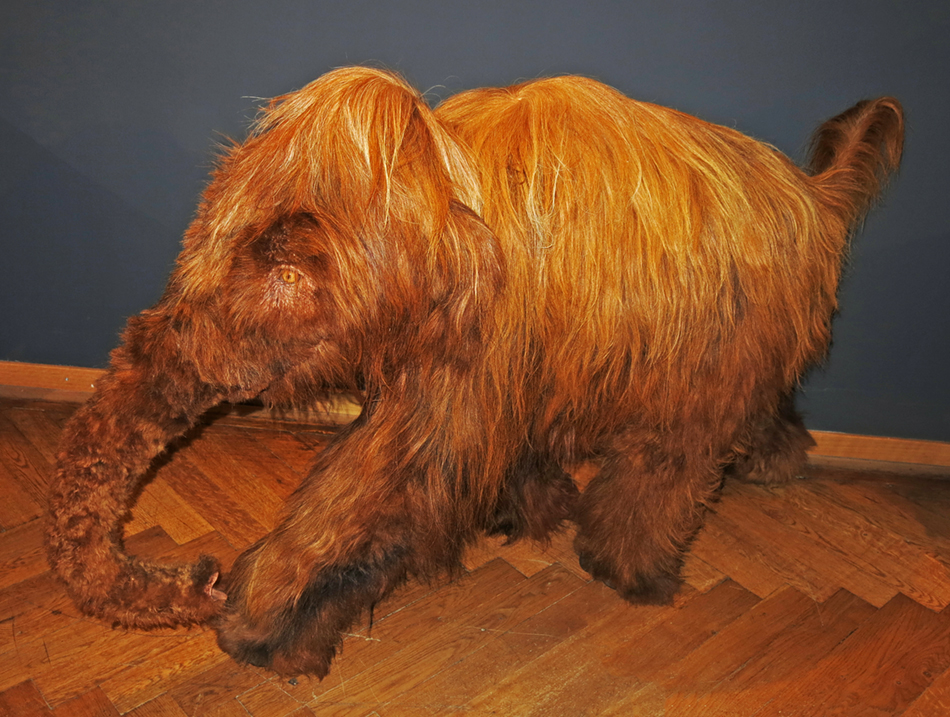Back to Don's Maps
Mammoths, Elephants and the Wooly Rhinoceros
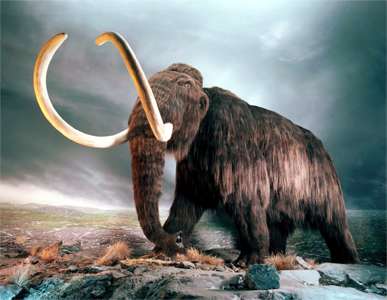
Photo: http://www.liveinternet.ru/users/3707322/post147516947/
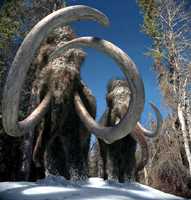
A beautiful recreation of two mammoths walking along a snow covered trail.
Photo: http://games.groups.yahoo.com/group/cavewars/

Situated in St. Petersburg on the Spit of Vasilievsky Island in the building on the corner of the Birzhevaya Square and Universitetskaya Embankment of the Neva River is the Zoological Institute of the Russian Academy of Sciences, the orange building at the end of the bridge above.
All St. Petersburgers are familiar from their childhood days with this building because it houses the Zoological Museum. However not everyone knows that the Museum is an exhibition part of the Zoological Institute: the most interesting part of the tremendous scientific collections of the institute is put on display in the museum. Not everyone knows that the Zoological Institute including the museum is one of the oldest scientific institutions in the city.
Text from: http://www.zin.ru/
Photo: Vladimir Gorodnjanski, 2007

Снимок сделан с набережной Невы.
Весна
На заднем фоне видна Петропавловская крепость.
Там хоронили царей.
Saint Petersburg is one of the world's most beautiful cities.
Photograph taken in spring, from the quay of Neva. In the background the Peter and Paul Fortress is visible, in which are buried the Tsars of Imperial Russia.
The Zoological Institute is at the end of the bridge in the background, though hidden by other buildings in this photograph.
Photo: Vladimir Gorodnjanski, 2007

In 2002 the institute became 170 years old although the history of establishment of collections at the institute and the museum began much earlier, i.e. since the time of Peter the Great, who purchased exhibits for the Kunstkammer, the first Russian museum established by him in 1714. Zoological specimens were added to the Kunstkammer collection after Peter the Great. The first museum catalogue (1742) lists approximately 4000 representatives of mammals, birds, amphibians, fishes, insects and invertebrates, deposited in scientific collections of the Kunstkammer.
Photo of the ZIN: Vladimir Gorodnjanski, 2007
The 18th century was the age of great expeditions including the famous academic expeditions of P.S. Pallas in the southern regions of Russia and Siberia. Information obtained in the expeditions provided the basis for many books including the famous monographs of P.S. Pallas (Zoographica Rosso-Asiatica), etc. and material collected in the expeditions was added to the 'natural cabinet' of the Kunskammer.
Extensive material collected during numerous marine and land expeditions of the early 19th century filled the depository of the Kunstkammer and the necessity arose to establish specialized museums, a zoological museum being among those.
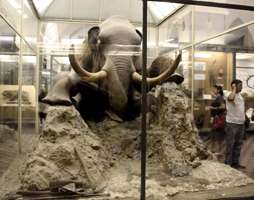
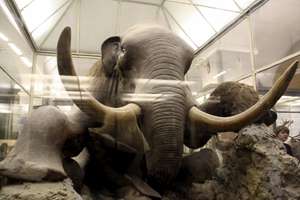
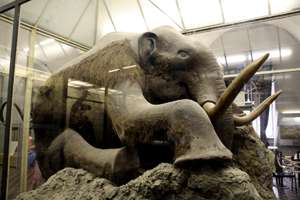
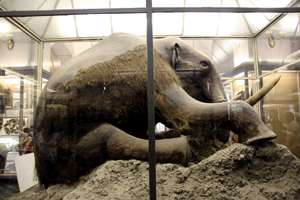
Text below from: http://www.zin.ru/collections/collect1.htm
The mammoth collection of the ZIN is unmatched. The most unique exhibit of this collection (and, undoubtedly, the most valuable exhibit of the museum) is a stuffed mammoth, the only exhibit of this kind in the world. When excavated, this mammoth was almost intact and retained skin, muscles, and innards. It was found in 1900 at the Berezovka River, a tributary of the Kolyma.
News of the finding reached the Academy of Sciences in April 1901 and in May, an expedition consisting of the zoologist O.F. Gerts, laboratory assistant E.V. Pfitsenmaier, and geologist D.P. Sevast'yanov was sent to excavate the mammoth.
The Berezovka mammoth is mounted in a strange posture: the animal appears to be sitting. It was frozen in this position in the permafrost 45 thousand years ago, when it fell down into a precipice or a crack and died. This finding provided the scientists with valuable information, in particular, on mammoth feeding, as food remains (grass) were revealed between the teeth and in the stomach. The Berezovka mammoth is the emblem of the Zoological Institute.
This Mammoth is on display in the St Petersburg Zoological Museum.
Photo: Vladimir Gorodnjanski, 2007
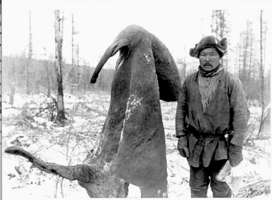
At the base of the woolly mammoth's tail was a broad flap of skin covering the anus. This has sometimes been regarded as a further adaptation to the cold, but it is also present in living elephants that inhabit a tropical climate. The anal flap was faithfully recorded by several prehistoric artists.
In the photo, a local Siberian poses beside a section of the Beresovka mammoth, found in 1901. Its short tail, at the top of the picture, has at its base the anal flap. The 86 cm (3 ft) long penis projects toward the bottom left.
Photo: Mammoths By Adrian Lister, Paul G. Bahn. MacMillan 1994

Painting depicting men fleeing from a mammoth.
Painting: La Fuite devant le Mammouth, oil on canvas by Paul Jamin, 1885
Collections of the Société Préhistorique française, from the Muséum national d'Histoire naturelle, Paris
Photo: Don Hitchcock 2018
Source: Musée de l'Homme, Paris
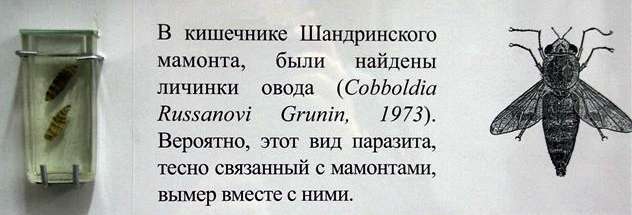
В кишечнике Шандринского мамонта, были найдены личинки овода (….). Вероятно, этот вид паразита, тесно связанный с мамонтами, вымер вместе с ними.
In the intestines of the Shandrinskogo mammoth, have been found larvae of an insect similar to the botfly. Possibly, this form of the parasite closely connected with mammoths, died out when they did.
Photo: Vladimir Gorodnjanski, 2007 from a display in the St Petersburg Zoological Museum
This model of a young mammoth was produced for a special exhibition. Though small samples of mammoth hair have been found, these ar too rare and precious for such a model. Therefore the skins of Scottish highland cattle were used for this replica.
Photo: Don Hitchcock 2015
Source and text: Natural History Museum of Vienna
Text below from: http://www.zin.ru/about_e.htm
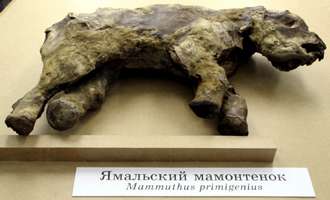
A very young mammoth snap frozen and revealed in melting permafrost, with much of its hair intact, though missing its trunk, on display in the St Petersburg Zoological Museum.
Photo: Vladimir Gorodnjanski, 2007

This young mammoth on display in the St Petersburg Zoological Museum appears to have been preserved in a peat bog.
It exhibits the classic black, shiny, flattened form of this method of preservation in anaerobic conditions, seen most often in the very detailed remains of humans preserved in peat bogs in northern Europe.
Photo: Vladimir Gorodnjanski, 2007
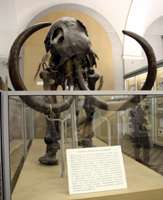
Mammoth on display in the St Petersburg Zoological Museum.
This is the famous "Adams mammoth" which was very important in the history of the understanding of mammoths and their evolution. See below.
Photo: Vladimir Gorodnjanski, 2007
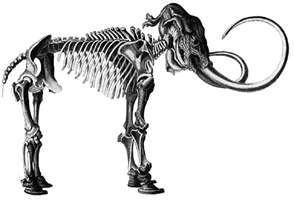
The identity of the Siberian mammoth was substantially revised in 1796 by George Cuvier. In the first paper he published Cuvier demonstrated—with the assistance of Messerschmidt's drawings—that the Siberian mammoth was distinct from living elephants. It was a different species. It was also extinct. The Siberian mammoth was formally named Elephas primigenius by Johann Friedrich Blumenbach in 1799. Much later, authorities realized that the mammoth was sufficiently distinct to warrant its own genus. It's now known as Mammuthus primigenius.
In the same year that Blumenbach named the mammoth, a hunter discovered one entombed in permafrost in a bank of the Lena River, Siberia. Over the next few years thawing freed enough of the carcass from the ice that the hunter was able to remove the tusks, which he sold to a merchant in the city of Yakust. In 1806 Mikhail (Michael) Adams, a Scottish botanist attached to the Russian Academy of Science, received word of the mammoth while traveling through Yakust. When his party reached it, they found a badly decomposed carcass. However, it still had considerable patches of skin and hair and most of the skeleton was intact. The find was transported to St. Petersburg, where it was mounted at the Zoological Institute. It became known as the Adams mammoth.
The dense hair of the woolly mammoth demonstrated that it was suited for the frigid Siberian climate. It was no longer necessary to explain the presence of tropical elephants in the Far North. Georges Cuvier, who had earlier proclaimed the mammoth to be a lost (extinct) species, argued that its entombment in ice was evidence for a sudden catastrophe.
Text adapted from: http://www.ansp.org/museum/jefferson/otherFossils/mammuthus.php
Photo: The Adam's Mammoth (after Tilesius, 1815), from the website http://www.ansp.org/museum/jefferson/otherFossils/mammuthus.php

Скелет Ленского мамонта
Целый труп мамонта был обнаружен в 1799 году охотником О. Шумаковым в береговом обрыве дельты реки Лены, на полуострове Быковском. В 1803 году туша полностью вытаяла из мерзлоты и оказалась на берегу; когда в 1806 году адъютант Академии Наук М.И. Адамс, находящийся в то время в Якутске, добрался до места находки, в сохранности оказался только скелет с остатками кожи и мускульных тканей. Уцелевшие останки были доставлены в Санкт- Петербург, где скелет был смонтирован и выставлен сначала в Кунсткамере, а затем в зоологическом музее Императорской Академии наук. Это был первый скелет мамонта, попавший в руки ученых. Абсолютный возраст находки, по данным радиоуглеродного анализа составляет 35 800 лет.
Skeleton of the Adams Mammoth from the Lena River
The corpse of the mammoth was discovered in 1799 by the hunter O.Shumakov in the bank of the Lena River, on the Bykovsky Peninsula. By 1803 the carcass was completely thawed out from the frozen ground and was visible at the bank. When in 1806 the Aide-de-Camp of the Academy of sciences, M.I.Adams who was at that time in Yakutsk, reached the place of the find, there was only a skeleton left with the remains of the hide and muscular tissues.
The recovered decomposed remains were delivered to Saint Petersburg where the skeleton was mounted and shown in a cabinet of curiosities, and then in a zoological museum of the Imperial Academy of sciences. It was the first skeleton of the mammoth which had come into the hands of scientists. The absolute age of the find, according to radiocarbon dating is 35 800 years BP.
Text: St Petersburg Zoological Museum
Photo and translation into english: Vladimir Gorodnjanski, 2007
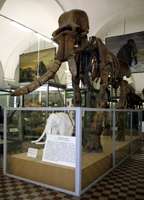


Южный слон
(Archidiscodon meridionalis)
Южный слон – один из крупнейших ( более 4.5 м высотой) представительей отряда Хоботовых, когда-либо населявших Землю. Обитал на территории Евразии и Северной Африки в степных и лесостепных ландшафтах в конце плиоцена.- древнем плейстоцене, около 2 млн. лет тому назад. Демонстрируемый скелет этого ископаемого зверя был найден на северном берегу Азовского моря, в окрестностях поселка Приморское в июне 1941 года. Раскопки были прерваны начавшейся войной, а в 1942 году скелет был вывезен в Германию. После окончания войны вместе с другими музейными ценностями уникальный экспонат был возвращен на украину, а затем передан Зоологическому музею Академии Наук СССР.
The Southern Elephant
(Archidiscodon meridionalis)
The southern elephant – one of the largest (more than 4.5 m in height) representatives of the group Hobotovyh, ever to occupy the Earth. Lived in the territory of Eurasia and Northern Africa in steppe and forest-steppe landscapes at the end of the Pliocene - ancient Pleistocene, nearly 2 million years ago. The skeleton of this fossil shown here was found on northern shore of the Azov sea, in the vicinity of the settlement Primorskoe (Seaside) in June, 1941.
Excavations were interrupted by the war, and by 1942 the skeleton was taken to Germany. After the termination of war together with other museum values the unique exhibit was returned to Ukraine, and then was transferred to the Zoological museum of the Academy of Sciences of the USSR.
Text translated by Vladimir Gorodnjanski, 2007 from the display in the Zoological museum of the Academy of Sciences of the USSR
Photo: Vladimir Gorodnjanski, 2007
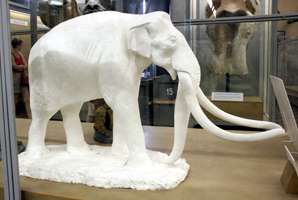
Mammoth on display in the St Petersburg Zoological Museum.
The small white plaster cast shows a model of the southern elephant, Archidiscodon meridionalis, the ancestor of the steppe mammoth and Mammuthus primigenius.
The most ancient finds of mammoths occur in the early Pliocene of Eastern and Southern Africa about 4 million years ago.
The south of Africa had very favourable landscape conditions for the existence of mammoths. Mammoths are usually allocated to the separate subfamily Mammuthinae, which is characterised by a skull with a circular top. The tusks are curved in a spiral fashion.
These first mammoths belonging to the genus Archidiscodon migrated from Africa to Eurasia and North America. The southern elephant is the direct ancestor of the steppe mammoth and Mammuthus primigenius. In the Americas, the southern elephant became the ancestor of the Columbian mammoths. The first mammoths were large, with a height of up to 4.5 metres at the shoulder.
Text adapted from: http://mammuthus.chat.ru/eng_evol.htm
Photo: Vladimir Gorodnjanski, 2007
Последние мамонты
На рубеже плейстоцена и голоцена ( менее 10 000 лет назад) море затопило большую часть арктического шельфа; ареал мамонтов сократился и представлял собой несколько относительно небольших изолированных участков на северо-востоке Сибири. В течение последующих 4 000 лет на острове Врангеля, отделившемся от материка 9 000 лет тому назад, сформировалась немногочисленная устойчивая популяция. Мамонты находились в крайне неблагоприятных условиях; животные мельчали за счет недостатка кормов в период раннего развития. Среди костей и зубов мамонтов, найденных на острове, сравнительно высок процент останков, говорящих о развитии различных болезней. Вместе с тем, использование взрослыми животными более широкого набора кормовых растений и отсутствие хищников приводило к тому, что большинство зверей доживали до старости и умирали своей смертью.
Причина окончательного исчезновения мамонтов на острове не ясна; возможно здесь не обошлось без участия человека, появившегося на острове около 3 200 лет тому назад.
Last mammoths
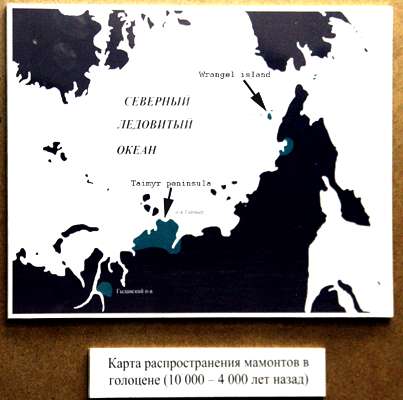
Map of the last known areas inhabited by mammoths on the mainland and Wrangel Island, where they survived until 3 200 years ago.
On the boundary of the Pleistocene and Holocene (less than 10 000 years ago) the sea flooded most of the Arctic shelf. The range of mammoths was reduced and were represented in few areas except for small isolated sites in the northeast of Siberia. During the next 4 000 years on Wrangel island, which was separated from the continent 9 000 years ago, a small stable population existed. These Mammoths lived in extremely adverse conditions; animals became small in stature due to lack of food during early development. Among the bones and teeth of the mammoths found on the island, the percentage of remains demonstrating the development of various illnesses is rather high.
At the same time, use by adult animals of a wider set of fodder plants and the absence of predators led to the majority living to a ripe old age.
The reason for the final disappearance of mammoths on the island is not clear; probably it did not occur without the help of those humans who appeared on the island about 3 200 years ago.
Photo: Vladimir Gorodnjanski, 2007, from an exhibit at the ZIN, St Petersburg.
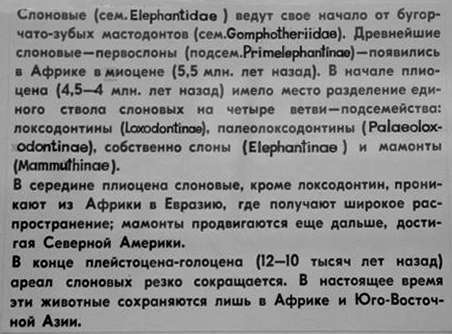
Mammoth information from the St Petersburg Zoological Museum.
Слоновые
Слоновые (семейство Elephantidae) ведут свое начало от бугорчато-зубых мастодонтов (семейство Gomphotheriiae) появились в Африке миоцене ( 5,5 млн. лет назад). В начале плиоцена ( 4,5-4 млн. лет назад) имело место разделение единого ствола слоновых на четыре ветви – подсемейства: локсодонтины ( Loxodontinae), палеолксодонтины (Palaeoloxodontinae), собственно слоны (Elephantinae) и мамонты (Mammuthinae).
В середине плиоцена слоновые, кроме локсодонтин, проникают из Африки в Евразию, где получают широкое распространение; мамонты продвигаются еще дальше, достигая Северной Америки.
В конце плейстоцена-голоцена (12-10 тысяч лет назад) ареал слоновых резко сокращается. В настоящее время эти животные сохраняются лишь в Африке и Юго-Восточной Азии.
The Elephant
The elephant (family Elephantidae) originated from knobbly - teeth mastodons (family Gomphotheriiae) appeared in the African Miocene (5.5 million years ago). In the beginning of the Pliocene (4.5-4 million years ago) there occurred a division of the common trunk elephant into four branches or subfamilies took place: Loxodontinae, Palaeoloxodontinae, the present day elephants (Elephantinae) and mammoths (Mammuthinae).
In the middle Pliocene the elephant, except for the Loxodontinae, travelled from Africa into Eurasia where they spread widely. Some moved even further, reaching Northern America.
At the end of the Pleistocene - Holocene (12-10 thousand years ago) the area occupied by elephants was sharply reduced. Now these animals live only in Africa and Southeast Asia.
Text: St Petersburg Zoological Museum
Photo and translation into english: Vladimir Gorodnjanski, 2007
Text below from: http://www.elephant.se/molar.php?open=Elephant%20anatomy
Mastodon means "breast-toothed"
Mastodon molars were low-crowned and fairly small and had three or four prominent transverse ridges of enamel. Mastodons have fewer ridges on their molar teeth than elephants and the ridges are also less elevated.

Archidiscodon meridionalis
Photo: Vladimir Gorodnjanski, 2007
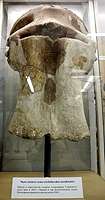
Череп южного слона, Archidiscodon meridionalis
Найден в окрестностях станицы Александрия, Ставропольского края в 1964 году. Передан в дар Зоологическому музею Пятигорским краеведческим мудзеем в 1965 году.
Skull of the southern elephant, Archidiscodon meridionalis
This skull was found in the vicinity of Alexandria village, Stavropol Territory in 1964. It was transferred as a gift from the Pyatigorsk museum of local lore in 1965.
Photo: Vladimir Gorodnjanski, 2007
Map: Adapted from http://encarta.msn.com/
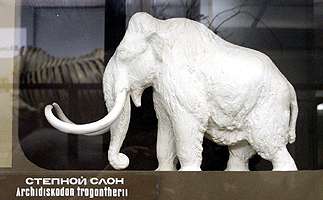
Archidiscodon trogontherii
Photo: Vladimir Gorodnjanski, 2007
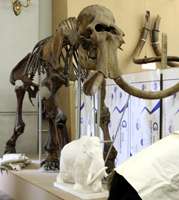
Mammuthus primigenius, the wooly mammoth.
Photo: Vladimir Gorodnjanski, 2007
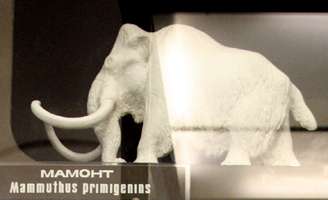
Mammuthus primigenius, the wooly mammoth.
Photo: Vladimir Gorodnjanski, 2007
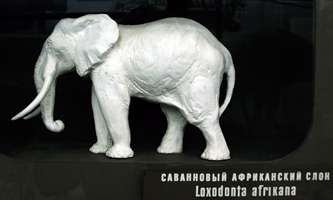
The African Elephant Loxodonta afrikana, the largest living land animal.
It may weigh up to 6 tons and measure 4 meters over the shoulder. The skin is of a greyish brown hue, very thick and with many deep folds. The three different subspecies are verty different in size and appearance. The Bush Elephant (Loxodonta afrikana africana) is the largest, weighing up to 6 tons, measuring up to 4 meters over the shoulder. It has large broad ears with a sharply pointed lower lobe. The tusks are longer and are usually curved forwards.
Loxodonta means "sloping teeth".
Text: http://www.limpopo-safaris.com/showpage.php?page=species_eng
Photo: Vladimir Gorodnjanski, 2007

The Forest Elephant (Loxodonta afrikana cyclotis) is smaller, weighing up to 4 tons, measuring 3 meters over the shoulder. It has smaller rounded ears with less pronounced lappets, and straighter, thinner and shorter tusks, usually projecting downwards. Sometimes, however, the Forest Elephant's tusks are longer than those of the Bush Elephant.
The Pygmy Elephant (Loxodonta afrikana pumilio): Is the smallest of the three, weighing up to 2 tons, measuring 1,8 - 2 meters over the shoulder. It has also smaller, rounder ears. The tusks are thin, very straight and also very short. It is reputed to be the most aggressive of the three. The Pygmy Elephant is only recognised as an individual subspecies by few zoologists. Most are of the opinion that it is an ecological subspecies rather than a different species, having adapted to an unfavourable habitat (confined to the swampy forest of Gabon and Congo), and being therefore of a much smaller size.
Text: http://www.limpopo-safaris.com/showpage.php?page=species_eng
Photo: Vladimir Gorodnjanski, 2007
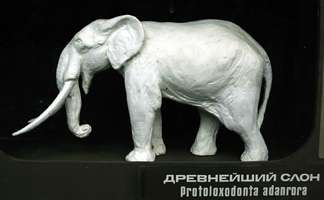
Protoloxodonta adanrora
Photo: Vladimir Gorodnjanski, 2007
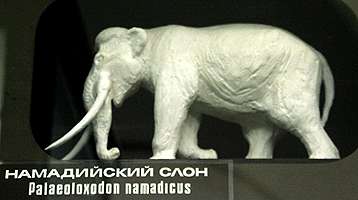
Palaeoloxodon namadicus
This is another name for Elephas namadicus.
Elephas namadicus was a relatively small (7 feet at the shoulders) prehistoric elephant that ranged throughout Pleistocene Asia, from India (where it was first discovered) to Japan, where the indigenous Neolithic cultures hunted that particular subspecies for food. It is a descendant of the Straight-Tusked Elephant.
Some authorities regard it to be a subspecies of Elephas antiquus, the Straight-Tusked Elephant, due to the extreme similarities of the tusks.
Text:Wikipedia
Photo: Vladimir Gorodnjanski, 2007
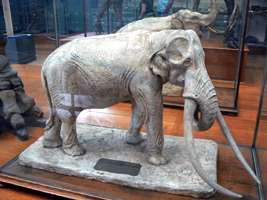
The Straight-tusked Elephant (Elephas (Palaeoloxodon) antiquus or Palaeoloxodon antiquus) is an extinct species of elephant closely related to the living Asian Elephant. It inhabited Europe during the Middle and Late Pleistocene (781 000 – 11 550 years before present). Some experts regard the smaller Asian species Elephas namadicus, as a variant or subspecies of this one.
The creature was 3.70 m (12 ft) tall and had long, slightly upward-curving tusks. Elephas antiquus's legs were slightly longer than those of modern elephants. It is suggested that this elephant had an 80 cm long tongue that could be projected a short distance from the mouth to grasp leaves and grasses. With this tongue along with a flexible trunk, straight-tusked elephants could graze or browse on Pleistocene foliage about 8 metres above ground.
Straight-tusked elephants lived in small herds of about 5 to 15 individuals. They preferred warm conditions and flourished in the interglacial periods during the Ice Ages, spreading from continental Europe to Great Britain during the warmer periods. It is assumed that they preferred wooded environments. During colder periods the species migrated south. It became extinct in Britain by the beginning of the last ice age, about 115,000 years ago. Eventually it was replaced by the mammoth
Text:Wikipedia
Photo: Wikipedia - photo taken at the Muséum national d'Histoire naturelle, Paris in August 2006 by "LadyofHats".
The photographer has graciously released it into the public domain.
The sculptor appears to have signed as M.F. Linsch, and the sculpture is at 1/8 scale.
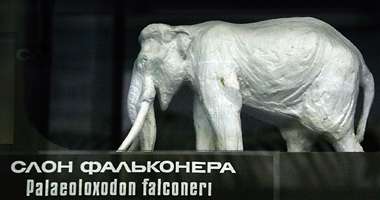
Palaeoloxodon falconeri
This is a dwarf elephant found as fossils on Sicily and Malta, dwarfed by the well documented process of the diminution of size of large animals confined to islands.
Photo: Vladimir Gorodnjanski, 2007

Palaeoloxodon melitensis
This is a dwarf elephant found as fossils on Sardinia, Sicily and Malta, dwarfed by the well documented process of the diminution of size of large animals confined to islands.
Photo: Vladimir Gorodnjanski, 2007

Palaeoloxodon antiguus
This is a mastodon, the remains of which were found in the area of Ambelia, Greece, dated to around 200 000 years.
Text: www.spring.net/yapp-bin/public/read/Geo/7
Photo: Vladimir Gorodnjanski, 2007
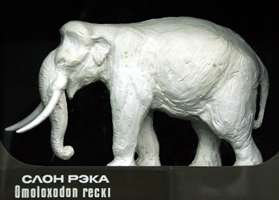
Omoloxodon recki
In 1955 Deraniyagala proposed the name Omoloxodon for Elephas recki of East Africa. This was based on several cranial characters.
Elephas recki is an extinct species of African elephant. At up to 15 feet (4.5 metres) in shoulder height, it was one of the largest elephant species to have ever lived. It is believed that E. recki ranged throughout Africa between 3.5 and 1 million years ago. The Asian Elephant is the only extant member of the genus. E. recki was a successful grass eating elephant that lived throughout the Pliocene and the Pleistocene until it was pushed to extinction in competition with members of the genus Loxodonta, the African elephants of today.
Text: Jstor (top) and Wikipedia (bottom)
(Researchers will find more information by searching for Elephas Recki than Omoloxodon recki - Don)
Photo: Vladimir Gorodnjanski, 2007
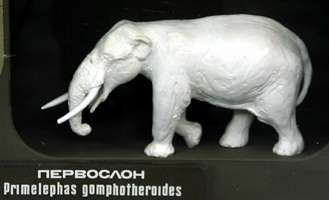
Primelephas gomphotheroides
Primelephas means first elephant, and is thought to be the ancestor of all elephants, and split up into three lineages, Loxodonta, Elephas, and Mammuthus.
The animal lived 5 million years ago in dense forests in Africa. It had tusks in both the upper and the lower jaw, it had an increased number of molar ridges, capable of grinding up rough vegetation, and had a longer trunk than Gomphoterium, an elephant like animal with fossil examples dating to 25 Million years ago.
Text: Adapted from www.elephant.se/primelephas.php?open=Extinct%20Proboscidea
Photo: Vladimir Gorodnjanski, 2007
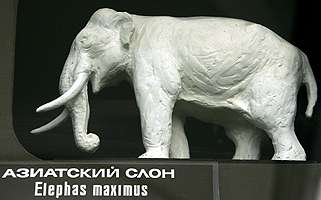
Elephas maximus
The Asian or Asiatic Elephant (Elephas maximus) is one of the three living species of elephant, and the only living species of the genus Elephas. The species is found primarily in large parts of Bangladesh, India, Sri Lanka, Indochina and parts of Indonesia. It is considered endangered, with between 25 600 and 32 750 left in the wild.
It is smaller than its African relatives; the easiest way to distinguish the two is that the Asian elephant has smaller ears. The Asian Elephant tends to grow to around two to four metres in height and 3 000 – 5 000 kilograms in weight.
The Asian Elephant has other differences from its African relatives, including a more arched back than the African, one semi-prehensile "finger" at the tip of its trunk as opposed to two, four nails on each hind foot instead of three, and 19 pairs of ribs instead of 21. Also, unlike the African elephant, the female Asian Elephant usually lacks tusks; if tusks — in that case called "tushes" — are present, they are barely visible, and only seen when the female opens her mouth. Some males may also lack tusks; these individuals are called "makhnas", and are especially common among the Sri Lankan elephant population. Furthermore, the forehead has two hemispherical bulges, unlike the flat front of the skull of the African elephant.
Text: adapted from Wikipedia
Photo: Vladimir Gorodnjanski, 2007
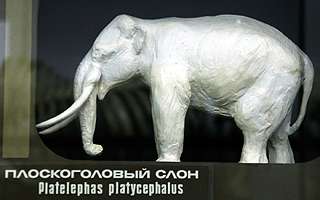
Platelephas platycephalus or Elephas platycephalus
The name means "flat headed" but there seems very little information on the net about this species, apart from the fact that it is extinct. I did find a pdf from 1929 with some information, see below.
Photo: Vladimir Gorodnjanski, 2007
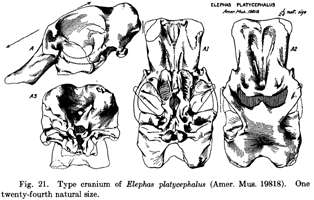
Elephas platycephalus
Subfamily: Elephantinae
Elephas platycephalus, new species
TYPE.-Amer. Mus. 19818. Cranium with M3 of both sides partly exposed.
Locality - Near Siswan, bed of Amilee Creek, Simla Hills, India.
Horizon - Found in separate mass of consolidated gravel which had apparently
been washed down from an original Boulder Conglomerate bed into a shallow region
bordering Amilee Creek. While not found in situ, it would seem to be of the same
Lower Pleistocene age as the Boulder Conglomerate formation above. Barnum Brown
Collection of 1922.
Specific Characters - Cranium of very primitive elephantine affinity, low, flattened; orbit widely separated from occiput; premaxillary rostrum somewhat broadened, resembling that of Elephas; posterior nares deeply indented; occipital condyles on relatively low plane, not greatly elevated above grinders; relatively long and narrow cranial proportions. Cranium widely different from the elevated Elephas hysudricus or the greatly elevated Elephas indicus crania. Ridge-plates of type molars fractured or absent. Estimated ridge-plate formula: M3 16½
See Chapter XX of the Proboscidea Memoir.
The discovery by Barnum Brown of this type below the Boulder Conglomerate renders it probable that Elephas platycephalus is of Lower Pleistocene or possibly Upper Pliocene age; in its dolichocephalic proportions it appears to be even more primitive than the Archidiskodon planifrons cranium of Upper Pliocene age.
Text and photo:
Number 393
Published by THE AMERICAN MUSEUM OF NATURAL HISTORY Dec. 24, 1929
New York City
56.9,61
NEW EURASIATIC AND AMERICAN PROBOSCIDEANS'
BY HENRY FAIRFIELD OSBORN
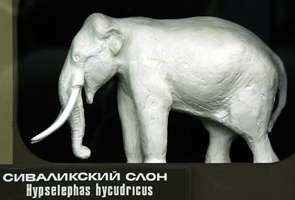
Hypselephas hysudricus
There appears to be an error in transcription on the sign of this model, which is labelled Hypselephas hycudricus
Photo: Vladimir Gorodnjanski, 2007
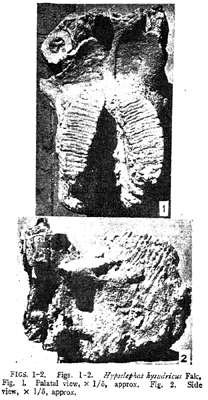
Hypselephas hysudricus
(This pdf is from "Current Science" from the September 20, 1968 issue, Vol 37, published in the archives of the Indian Academy of Sciences. My thanks to them for making this information available. I have OCRd and proofed the original image into standard html to make it more readily accessible to search engines and save space. The original may be found as a link at www.ias.ac.in/j_archive/currsci/37/vol37contents.html - Don)
Current Science
On the Occurrence of Hypselephas Hysudricus in the Pleistocene: Deposits of Tirunelveli, Madras State.
Published with the kind permission of the Director-General, Geological Survey of India.
K. N. PRASAD
Geological Survey of India, Hyderabad
And
J. A. DANIEL
Zoology Department, V.O.C. College, Tuticorin
The evolutionary history of proboscideans has always been of great interest to Vertebrate Palaeontologists. As pointed out by Osborn they rank next to man in biological importance and far surpass the mechanically inferior man in demonstration of all the main principles of biomechanical aristogenesis and alloimetry. The material under description, a partial skull was recovered from Ayyanidipu (8° 45' N 78°7' E) 6.5 kilometres west, on the Tuticorin - Palayamcottah road.
A small patch of late Tertiary sediments of probable Pliocene - Pleistocene age occurs in a series of detached outcrops in the coastal belt of Tirunelveli - Tuticorin. A brief note on the present find was published by Easterson without assigning the material to any specific group. Therefore, a detailed description of the skull has been attempted by the authors.
A few well sections near Sayamalai (9° 5' N 77° 4' E), Tirunelveli District, have also yielded a few vertebrate fossils of Pleistocene age (Tripathi). Critical field studies by one of us (Prasad) of a number of well sections reveal that the tuffaceous kankar bands and the compact sandstones containing the vertebrate fossils are barely five to six metres thick and overlie the Archaeans directly. The occurrence qf Hypselephas hysudricus in this part of the region is of considerable interest as it throws some new light on the distribution of the group Elephantinæ during the Pleistocene times. This is the first record of Hypselephas from the Pleistocene beds other than the Siwaliks of Punjab Himalayas.
Genus Hypselephas Osborn 1936
Genotypic species:
Hypselephas hysudricus Falconer, 1845
The original material described by Falconer from the Siwaliks is from the Lower Pleistocene. He considered Elephas hysudricus as related to E. indicus. Adams believed them to be ancestral to Loxodonta and Elephas. On the other hand, Pohlig considered them as ancestral to Elephas namadicus. However, Osborn regarded them as more closely related to E. indicus although by no means ancestral. Forty-three specimens are known from the Siwalik (Lower Pleistocene) beds of Punjab.
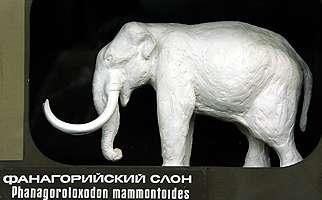
Phanagoroloxodon mammontoides
It is possible that the forests were occupied by Phanagoroloxodon mammonthoides Garutt (Garutt 1957) on the territory of the Sea of Azov at the end of Pliocene and at the beginning of the Pleistocene.
Text: www.cq.rm.cnr.it/elephants2001/pdf/152_156.pdf
Photo: Vladimir Gorodnjanski, 2007
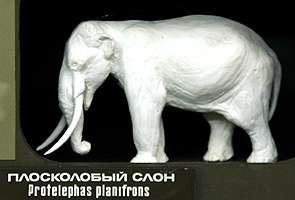
Protelephas planifrons
Photo: Vladimir Gorodnjanski, 2007
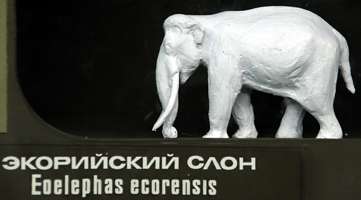
Eoelephas ecorensis
Photo: Vladimir Gorodnjanski, 2007
The Turkmen Elephant (Palaeoloxodon turcmenicus)
Туркменский слон (Palaeoloxodon turcmenicus)
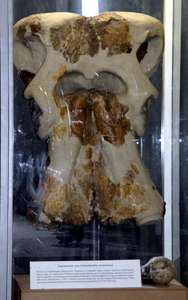
Туркменский слон
Обитал на территории современной Украины и Средней Азии в начале среднего плейстоцена около 1 млн. лет назад. Отличался крупным ( высота до 4.5 м) размерами,
Относительно коротким туловищем, и длинными почти прямыми бивнями. Демонстрируются череп и обломок бедерной кости, найденные в 1943 году вблизи поселка Худай-Даг на юго-западе Туркменистана. Окончательные раскопки проводились экспедицией Академии Наук СССР в 1952 году.
The Turkmen elephant.
This member of the elephant family lived in the territory of modern Ukraine and Central Asia in the beginning of the middle Pleistocene around 1 million years ago.
It had a height at the shoulders of up to 4.5 metres. It had a relatively short trunk, and long almost straight tusks. The skull and a fragment of the femoral bones were found in 1943 near the settlement of Hudaj-Dag in the south west of Turkmenistan.
The final excavation was completed by an expedition of the Academy of Sciences of the USSR in 1952.
Photo: Vladimir Gorodnjanski, 2007
Lyuba, the baby mammmoth
Frozen baby mammoth found in Siberia
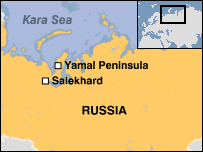
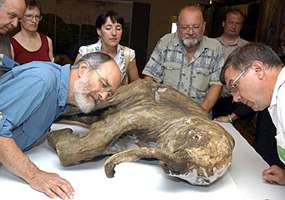
Scientists in the arctic city of Salekhard inspect the carcass of a baby mammoth found in May in the Yamal-Nenets autonomous district in Russia's north. The carcass, seen in a photo taken on July 2, is considered to be the best preserved specimen of its type, scientists said.
Map: http://news.bbc.co.uk/2/hi/science/nature/6284214.stm
Photo: http://www.thestar.com/News/article/234736
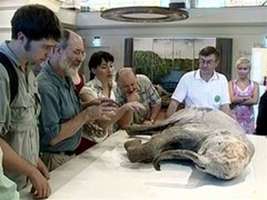

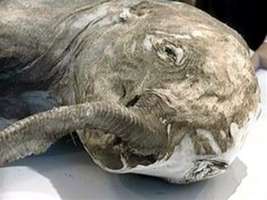
Photo: http://www.modbee.com/ From: NTV, Russian Television Channel -- AP Photo
The frozen carcass of a 10 000-year-old baby mammoth has been unearthed in a remote northern Siberian region, a discovery scientists said Wednesday could help in climate change studies.
The 1.2-metre grey-and-brown carcass, discovered in May by a reindeer herder near the Yuribei River in the Yamal-Nenets region, has its trunk and eyes virtually intact and even some fur remaining, said Alexei Tikhonov, deputy director of the Russian Academy of Sciences' Zoological Institute.
The animal's tail and ear appeared to have been bitten off, he said.
"The mammoth is an animal that you look at and you see that there is an entire epoch behind it, a huge time period when climate was changing," he said in comments broadcast Friday.
"And of course when we talk about climate change, we must use the knowledge that we will get from them (mammoths)."
Scientists believe mammoths lived from 4.8 million years ago to around 4 000 years ago. Studies suggest climate change or overkill by human hunters as possible reasons leading to their extinction.
Tikhonov said the mammoth would be sent to an institute in Japan for further study.
Global warming has made it easier for woolly mammoth hunters to hack the animal out of Russia's thawing permafrost. An entire mammoth industry has sprung up around the far eastern frontier town of Yakutsk.
Many examples are simply sold on the black market - and can be seen in Russian souvenir shops, next to unhappy-looking stuffed brown bears.
Text below from: http://www.themoscowtimes.com/stories/2007/07/12/003.html
Photo below from: http://news.bbc.co.uk/2/hi/science/nature/6284214.stm
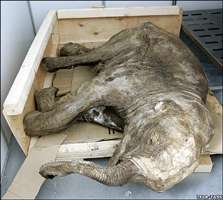
Lyuba was only about four months old when she died on a full stomach. Ten thousand odd years later she is set to become world famous.
Scientists have hailed the discovery of the baby woolly mammoth, dubbed Lyuba, as one of the finest examples of preserved mammoths ever discovered after it emerged from the melting permafrost in western Siberia.
"There has never been such a find," Pavel Kosintsev, one of the first scientists to see the mammoth, said in a telephone interview from Yekaterinburg.
"The mammoth is an animal that you look at and you see that there is an entire epoch behind it, a huge time period when climate was changing," said Alexei Tikhonov, deputy director of the Russian Academy of Sciences' Zoological Institute in televised comments last week.
With her trunk still intact, eyes in place and small tufts of fur still on her skin, Lyuba looks more like a museum fake than a link to life in the Ice Age, though her tail seems to have been nipped off.
One hundred and thirty centimeters long, 90 centimeters high and weighing only 50 kilograms, the mammoth is almost exactly as it was when it died nearly 10,000 years ago, said Kosintsev, deputy head of the Zoological Museum in the Institute of Ecological Plants and Animals.
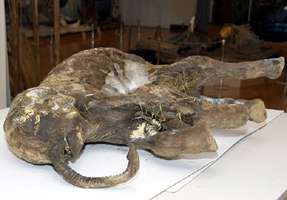
Photo: http://in.today.reuters.com
"The animal died and immediately was buried in a watery area or a bog. There was no decay. She was located there in a frozen state for several thousand years," said Kosintsev. Lyuba likely reappeared to the world after the river's bank slipped at the end of last year, he said.
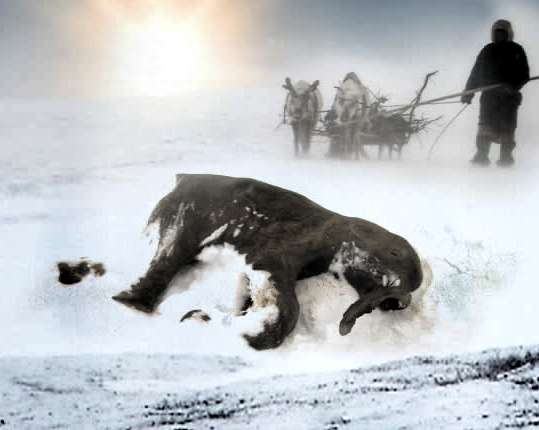
Photo: recreation of the finding by National Geographic.
From http://channel.nationalgeographic.com/episode/waking-the-baby-mammoth-3630/Overview
Lyuba was found almost two months ago on May 15 by Yury Khudi, a nomadic reindeer tribesman near the Yuribei River in the Yamal-Nenets autonomous region. Khudi, a Nenets, thought it was a sick reindeer at first and went to investigate, said Kosintsev. When he saw that it was a mammoth, he went to the nearest village to tell of his find.
She was named Lyuba by scientists in honor of Khudi's wife, though how he feels about that is not yet known as he is back in the tundra with his reindeer.
"We could not contact him, but if he says it is not the right name we will change it," said Kosintsev. Mammoth finds are usually named after the person who finds them.
To keep her from deteriorating, Lyuba is being stored at minus 10 degrees Celsius in an industrial freezer in the Yamal-Nenets republic's regional museum in Salekhard, the regional capital.
Mammoths, believed to be close relatives of the modern day elephant, roamed the earth from almost 5 million years B.C. to just a few thousand years B.C. when they disappeared.
Although mammoths once inhabited almost the entire world, Russia has always had a strong association with the beast. Mammoths are considered special animals by northern tribes, said Natalia Fyodorova, the deputy director of the museum, in a telephone interview from Salekhard.
"All the native tribes have tales about this mythical animal," she said. When finding mammoth parts, native tribes such as the Nenets often take them to their holy places to talk with their souls. Now, she said with a touch of pride, "they tell the museum."
It is not only the native tribes who have their explanations for the mysterious animal. One mythic explanation for the existence of the woolly mammoth in the far reaches of Russia is that they were the last of Carthaginian General Hannibal's war elephants after they crossed over the Alps into Italy in the second century B.C.
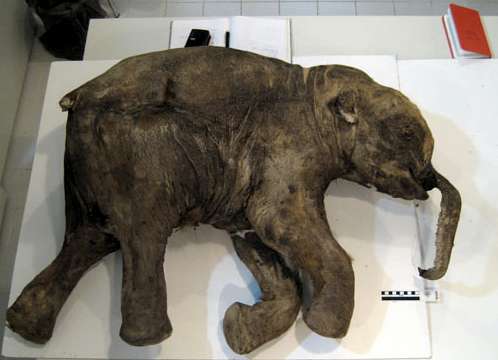
Photo: Daniel Fisher, University of Michigan, from: http://www.archaeology.org/0801/topten/lyuba.html
An international conference gathered last month in Salekhard, including experts from the United States and France, to decide what to do with the mammoth.
Lyuba will go to Japan soon for a CT scan at Jikei University to be examined by a team led by professor Naoki Suzuki. "It will give a unique chance to compare the herbivores of then with today's," said Suzuki, Itar-Tass reported. After going to Japan, Lyuba will return to Russia.
"I think she will not only be shown in Salekhard but all over the world," said Fyodorova.
Text below from: http://archaeology.about.com/od/laboratoryanalyses/ss/waking_baby_3.htm
After her discovery, Lyuba was transferred to the city of Salekhard in Russia and stored at the Salekhard museum of natural history and ethnology. She was temporarily shipped to Japan where a computed tomography scan (CT Scan) was conducted by Dr. Naoki Suzuki at the Jikei University School of Medicine in Tokyo Japan. The CT scan was conducted ahead of any other investigation, so that researchers could plan a partial autopsy with as little disturbance of Lyuba's body as possible.
The CT Scan revealed that Lyuba was in good health when she died, but that there were large amounts of mud in her trunk, mouth and trachea, suggesting that she may have suffocated in soft mud. She had an intact "fat hump", a feature used by camels—and not a part of modern elephant anatomy. Researchers believe the hump regulated heat in her body.
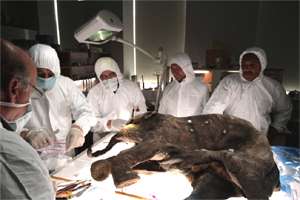
At a hospital in St. Petersburg, researchers performed investigative surgery on Lyuba, and removed samples for study. The researchers used an endoscope with a forceps to examine and sample her internal organs. They discovered that she had consumed her mother milk, and her mother's feces—a behavior known from modern baby elephants who consume their mothers' feces until they are old enough to digest food themselves.
From the left, Bernard Buigues of the International Mammoth Committee; Alexei Tihkonov of the Russian Academy of Sciences; Daniel Fisher of the University of Michigan; reindeer herder Yuri Khudi from the Yamal Peninsula; and Kirill Seretetto, a friend from Yar Sale who helped Yuri connect with the science team.
Photo: © Pierre Stine
Photo and text from http://archaeology.about.com/od/laboratoryanalyses/ss/waking_baby_4.htm
Elephant hunters of the Stone Age
Most photos and text from: http://thehumanjourney.net/
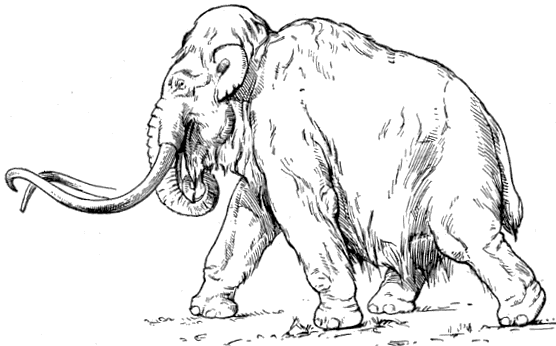
Archaeological excavations, in advance of the Channel Tunnel Rail Link, have revealed an undisturbed 400 000 year old Early Stone Age site in the Ebbsfleet Valley, near Swanscombe, Kent. The skeleton of an elephant has been preserved in the muddy sediment near what was then the edge of a small lake. It is surrounded by flint tools, which lie undisturbed from where they were originally discarded.
Photo: H. Osborn, 'Men of the Old Stone Age' (1916), Palaeoloxodon antiquus.
The work was carried out by Oxford Archaeology on behalf of Rail Link Engineering.
Helen Glass- Archaeological project Manager for Rail Link Engineering said "This is an amazing discovery. During our archaeological work at Ebbsfleet we have found an Anglo-Saxon mill and a Roman Villa, we thought we'd found everything, but it seems that the best has been saved until last". The site was first discovered by Dr. Francis Wenban-Smith of Southampton University, Stone Age specialist for the project, during routine archaeological monitoring late in 2003.
Later investigations with geological specialist Dr. Peter Allen identified the presence of the lakeside sediments, and the elephant skeleton was discovered in the course of the more detailed excavations that followed. It is uncertain whether the elephant was deliberately driven into the boggy ground and then killed, or whether it became trapped on its own. The manufacture of stone tools at the same spot, which would have been unsuitable for human occupation, almost certainly reflects butchery of the carcass for its meat.
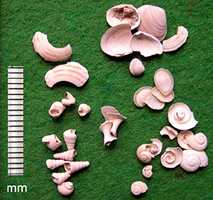
Molluscs from the site
Photo: Francis Wenban-Smith
According to Dr. Wenban-Smith "This is a very exciting find. Only a handful of other elephant remains have been found in Britain, and none of these give any indication of human exploitation. This would have been a pretty hefty beast. It would have been over twice the height of a man, and weighed three or four times the weight of an average family car. It is hard to imagine early humans successfully hunting a healthy specimen, but if it was already trapped in the bog, it could have been killed by early humans with wooden spears, and then butchered for its meat with flint tools. What we need now is to find some more of its bones, see if they have cut-marks proving that it was butchered for its meat, and find out which parts of the elephant they preferred to eat. The steaks produced from even just this one beast would have fed a family of four for a month, although the meat would probably have been pretty rancid towards the end, since they lacked any means of refrigeration."
The elephant has been identified by Simon Parfitt of the Natural History Museum as the extinct Straight-tusked Elephant (Palaeoloxodon antiquus), which was last present in England over 100 000 years ago. Bones from other large animals including buffalo and wild horse have also been found. Sieving of the sediments at the site has produced a wide range of evidence that reveal the climate and local environment, as well as helping date the site. The presence of sticklebacks, frogs, newts and aquatic molluscs confirm the presence of standing water at the site. The presence of pollen grains from a number of tree species — including birch, pine, oak, elm, alder and hazel — and teeth from a woodmouse indicate an interglacial climate, similar to or warmer than the present day, with the lake surrounded by woodland, probably with some open areas due to heavy grazing.
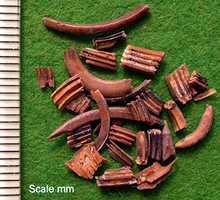
Vole teeth from the site
Photo: Francis Wenban-Smith
Most importantly, the presence of two species of vole — water vole (Arvicola cantiana) and pine vole (Pitymys arvaloides) — allow the site to be accurately dated by means of the so-called "vole clock". Investigations at sites across Europe have allowed construction of a detailed framework of how different vole species evolved over the last million years, and where and when specific species became extinct.
Of the two vole species found at the Ebbsfleet site, the pine vole has been extinct in England for the last 400 000 years and the type of water vole found has only been present for the last 500 000 years. Taken together, the two species help to date the site to the Hoxnian interglacial, a warm phase for which deposits are also preserved at nearby Swanscombe. Dr. Wenban-Smith said "The vole clock is one of the wonders of modern science.
It is truly incredible that the tiny remains of these creatures are so well preserved. For many sites it is the most accurate way of dating, and they also provide wonderfully precise information on the climate and local environment."
The deposits at the Ebbsfleet site are slightly older than those that produced the skull of "Swanscombe Man" — in fact now thought to be female — over 50 years ago at Barnfield Pit, Swanscombe about 2km away, but younger than those at Boxgrove, where a shin bone was found in 1993.
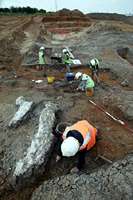
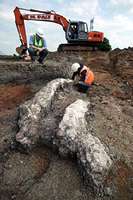
Palaeoloxodon antiquus under excavation.
Photo: Union Railways.
However, these sites are close enough in time to be sure that the same early species of hominid was responsible for the archaeological evidence. Due to the rarity of hominid skeletal material from this early period it is uncertain which species of hominid this is. Most experts agree that these early English finds should be attributed to Homo heidelbergensis, a close cousin of Homo erectus. Their brain size would have been about 75% of our own, but they would have walked fully upright as we do. They gradually evolved into Neanderthals, who became extinct in the middle of the last ice age, about 30 000 years ago, when modern humans colonised the majority of the globe.
According to Dr. Wenban-Smith "despite their limited technology, their ability to make sophisticated flint tools and survive without the aids we take for granted today, suggests we should not jump to the conclusion that they were fundamentally different in their intellectual capabilities. In fact it is highly likely they were able to communicate with each other using verbal abstractions, much as we do in the present day, although with a much more restricted vocabulary. Tantalisingly, we have yet to see the face of Swanscombe Man. What we would really love to find at the site is the front of a hominid skull of this early period. That would be awesome."
Uses of Mammoth Ivory
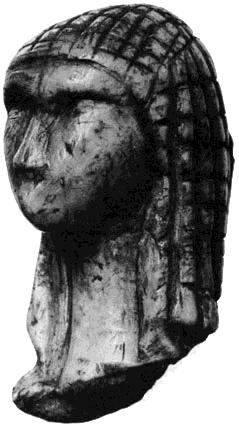
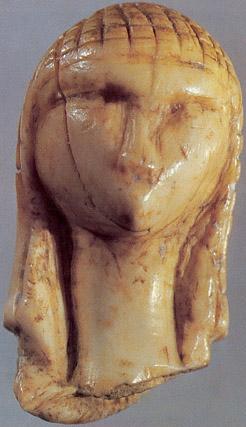
This miniature head (3.5 cm, (1.5 inches) was carved from mammoth ivory. Found at Brassempouy, Landes, France. It may be 30 000 years old. It is one of the few Ice Age figures with facial features and a detailed hairstyle. It is the original for the 'Ayla' head from Jean Auel's Earth Children series of books. Some doubt its authenticity, since it was recovered at a dig where the workers were paid by what they discovered.
Photo:
T. Powell 'Prehistoric Art'
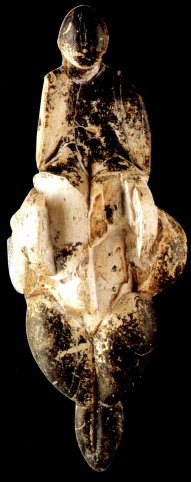
Front view of the Lespugue Venus. This venus was carved from mammoth ivory and was damaged during excavation.
The obese form and exaggerated hips and breasts of the figure are common in many of the hundreds of venus figures from Europe.
Photo: http://www.toila.org/IMPalaeoG2.html
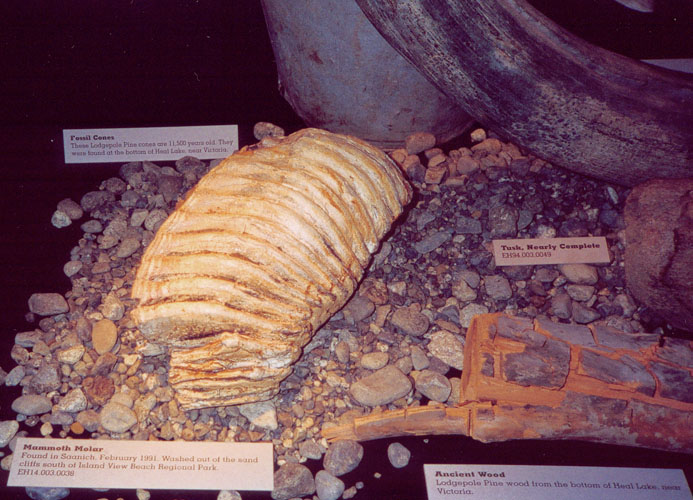
Photographed in the shop window of a store in Jasper, Alberta.
Photo: Don Hitchcock 2000
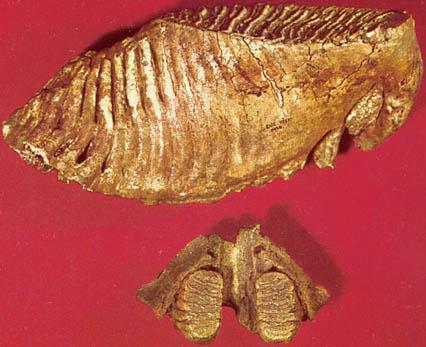
Photo: J. Jelinek, The Evolution of Man
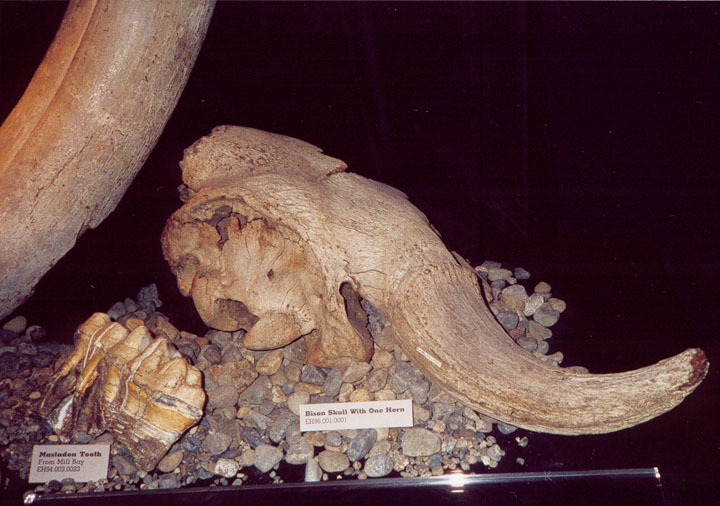
Photographed in the shop window of a store in Jasper, Alberta.
Photo: Don Hitchcock 2000
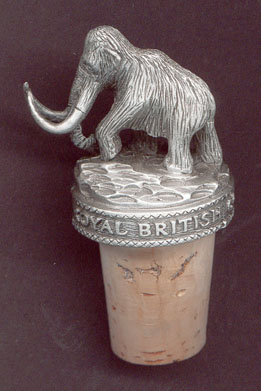
On sale in the Royal British Columbian Museum in Victoria, B.C.
Photo: Don Hitchcock 2000
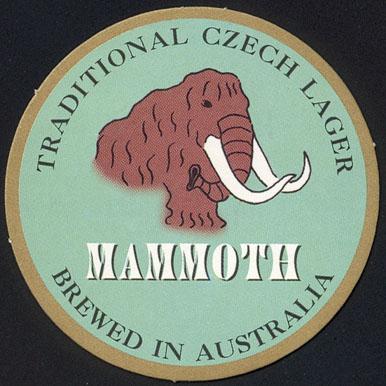
Photo: Don Hitchcock 2001
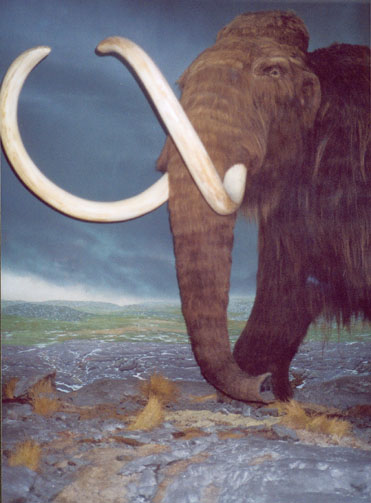
Photo: Don Hitchcock 2000
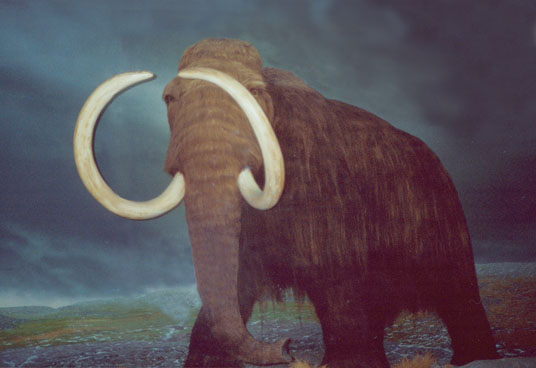
Photo: Don Hitchcock 2000
The following pair of animals, the southern mammoth and the hippopotamus, ranged over western Europe from the close of the Pliocene to the middle of the third interglacial, and were hunted by the early Neanderthals and their predecessors. They are associated in western Europe in the third interglacial with flints of Pre-Chellean, Chellean, and early Acheulian age.
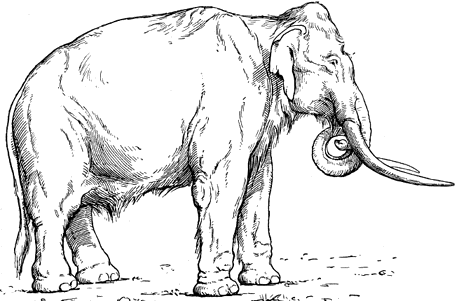
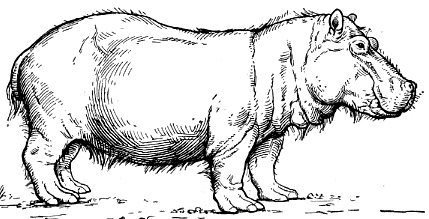
The following pair of animals (the broad nosed or Merck's rhinoceros, and the straight tusked or ancient elephant) replaced the pair above and were hunted by the Neanderthals, but not by Cro Magnon man. By the time that modern man appeared on the scene, these hardy large African-Asiatic mammals had been replaced by the woolly mammoth and the wooly rhinoceros.
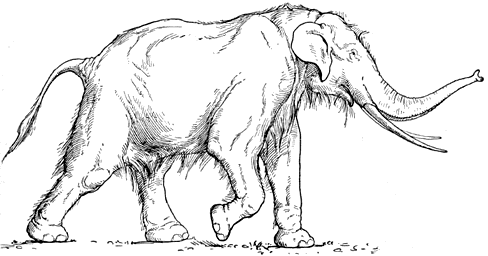
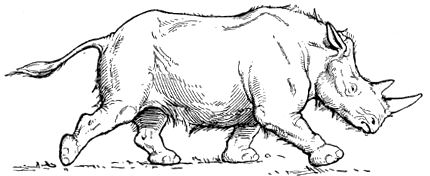
As the last great ice age (the fourth, or Wurm) began, the advancing ice of the Wurm glaciation forced tundra animals further south into western europe. The increasingly cold conditions altered the vegetation as well. The spruce, fir, and arctic willow were now found only in the more sheltered river valleys, while the rest of the landscape was mostly deforested. Animals from as far east as the Obi River on the eastern side of the Ural Mountains in present day Russia migrated into western europe, specifically the obi lemming. Once again the pair of large herbivores were replaced, this time by the woolly mammoth and the woolly rhinoceros.
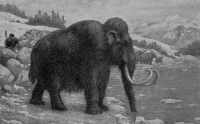
The woolly
mammoth Elephas primagenius
Photo: H.
Osborn, 'Men of the Old Stone Age' (1916)
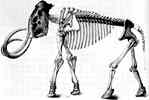
Skeleton of a mammoth reconstructed from bones found in various caves in France.
Photo : Man before History by John Waechter
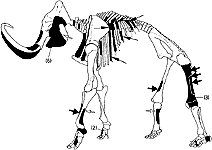
Body-part representation of mammoths (shaded). Numbers in parentheses indicate the minimum number
of individuals counted on each element. Short arrows in bold face: impact marks. Long narrow arrows:
cut marks. White arrows: breakage probably resulting from a heavy blow. Outline after Mol & Essen (1987).
From Fladerer (2001).
Photo : The World of Elephants - International Congress, Rome 2001
The Krems-Wachtberg camp-site: mammoth carcass utilization along the Danube 27,000 years ago
F.A. Fladerer
Institute of Paleontology, University of Vienna, Vienna, Austria
florian.fladerer@univie.ac.at

Mammoths in a winter landscape
Photo: http://dsc.discovery.com/convergence/landofmammoth/eyecandy/main.html

Dr Len Hills by mammoth tracks revealed in the St. Mary's Reservoir, southern Alberta, in 1999.
By an extraordinary quirk of geological fate, sediments from St Mary's Reservoir in southern Alberta have preserved a rich array of bones and footprints from Alberta's Ice Age: mammoth, musk-ox, horse, caribou, camel and giant bison. Some are more than 11,000 years old.
From: http://www.pma.edmonton.ab.ca/events/timetrav/vii/_tracks.htm
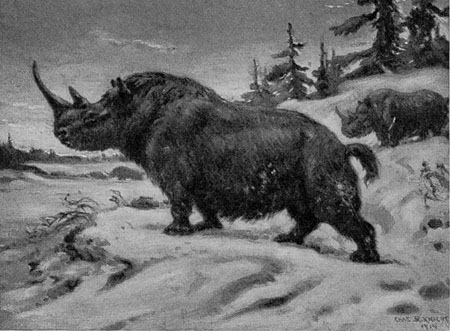

Raising the Mammoth
Herewith an article on a frozen mammoth, from the excellent Australian magazine The Bulletin.
A two hour documentary of the find and exhumation was screened on cable television's Discovery Channel in a rare global prime-time screening of Raising the Mammoth on March 12 2000 in 146 countries (including Australia) and 23 languages.
I presume water was used to reglue the mammoth tusks into their sockets. A glue is something which wets both surfaces and then hardens. You can make quite a serviceable shelter in freezing temperatures using nothing but water to wet the surfaces to be glued, then allowing the joint to freeze.
But be wary of sudden spring thaws.

The Bulletin, February 8, 2000
..............despite enduring many prior severe climate changes, when the last ice age ended about 12,000 years ago most of those beasts were either already dead or doomed. The wiping out of megafauna was not restricted to Siberia: scores of species in Australia, North America, Europe and Asia cashed in their chips about the same time. It was devastating.
Species that had existed for millions of years and ranged over much of the globe simply vanished in the geological equivalent of the blink of an eye. is still unclear exactly why they perished and is debated vigorously in scientific circles - humans are on the scene with no alibi, heavily implicated through hunting and causing habitat change - but now an extraordinary window into that ancient world is set to open because of the determined efforts of a French adventurer, Bernard Buiges.
Buiges has managed to recover virtually the entire body of a woolly mammoth, which had lain snap-frozen for millennia in, the Siberian permafrost. Carbon dating suggests it died more than 20,000 Years ago: it was a male aged 46, tests have revealed.
Plenty of mammoth remains have been found before. In 1996, for example, Mexican construction workers found the skeletons of an entire herd of seven animals, buried 12,500 years ago in volcanic ash and mud. Other frozen mammoth bodies have also been found in Siberia and elsewhere.
But the body found by Buiges seems so well preserved that it promises to be a special find. Seeds, pollen and other plant parts may still cling to its coat; the remains of its last meals may be present in its stomach; its teeth, tusks, muscles and what may be some of the oldest mammoth blood cells ever studied will all have stones to tell about its life and times.
What's more, it's the first to emerge from the deep freeze into the clone age.
Already the tantalising possibility has been raised that the latest reproductive technologies may be used to breathe new life into this charismatic beast. It is hoped the cloning techniques being developed by Scottish and other scientists - as demonstrated spectacularly by the now famous sheep Dolly - can be adapted for use in this situation, probably using an Asian elephant as the surrogate mother. Either a cell from the mammoth's body, or perhaps an intact sperm, would yield the genetic blueprint.
To do so would be a major technical feat if nothing else, not least because elephants are notoriously difficult to breed. But if it succeeded, a live mammoth would walk the Earth for the first time in thousands of years.
The very word mammoth has become a fixed part of our collective imagination, used to indicate something huge or gigantic. The truth is, however, that mammoths were no larger than the Asian elephant, and a little smaller than the African elephant.
Yet they were impressive animals. Based on elephant studies, it's thought that a fullgrown adult mammoth stood up to three metres tall at the shoulder. it would have eaten up to 200 kilograms of food and needed more than 180 litres of water a day, having to forage for at least 14 hours simply to sustain itself. Some of the largest weighed up to 8 tonnes.
Mammoth tusks are unusual not simply for their size but for their shape and the way they are arranged, pointing downward, and, in older animals, curling back around on themselves almost full circle. it has been suggested they served as snowploughs, clearing the way for the animals to reach the plants they sought: they are known to have eaten grasses, buttercups, mosses and even lichens.
And as extinct prehistoric animals go, woolly mammoths seem to run second only to dinosaurs for public interest. Dinosaurs were wiped out 60 million years before humans even began to evolve, whereas people and mammoths co-existed for many tens of thousands of years.
Over time, many mammoth species existed, inhabiting every continent but Australia, South America and Antarctica, notes Colin Groves, a reader in biological anthropology at the Australian National University and an expert in human and mammal evolution.
Groves has a special interest in elephant evolution. He says the ancestors of elephants first appeared about 5 million years ago in Africa, the same time our own ancestors diverged from the chimpanzees. Asian elephants first evolved about I million years later, and genetic studies have shown mammoths emerged from that branch of the family line.
They later diversified, evolving into many species and even becoming dwarfed when trapped by rising seas on small islands. The last known living mammoths, a dwarf species living on Wrangel Island, off Siberia, died out only 3,700 years ago.
The woolly mammoth seems to have been superbly adapted to cold climates, with its thick coat and dense fatty layers of insulation. There is no question that people hunted and ate them. Frozen and fossilised caches of mammoth meat have been found, while stone-pointed spears and other thrusting weapons tough enough to pierce their thick hides have been discovered within mammoth skeletons in North America. In Russia, archaeologists have found large and elaborate houses built up to 28,000 years ago and constructed entirely from hundreds of mammoth bones.
The suggestion of cloning a mammoth - first put forward last year by Japanese scientists - raises many issues for public debate and throws a whole new light on this latest find. Buiges has spent a decade organising treks and tours to the Arctic and Siberia. It was on one of these in 1998 that he heard that members of the Dolgan tribe - indigenous Siberian nomadic hunters and reindeer herders - had some very special ivory for sale.
His curiosity led him to the Jarkov family, and to Buiges' amazement their ivory turned out to be a pair of tusks from a woolly mammoth. Some of the Jarkov men had found the tusks sticking out of the permafrost a year earlier.
They had found mammoth bones and teeth before, but these tusks were of high quality. They were from a mature animal, were in very good condition and weighed about 100 kg. With ivory fetching $US200/kg ($A306/kg) on the local market, the canny Jarkovs were not about to rush into selling them to the first buyer.
"To them it was a great treasure," Buiges recalls from his Paris home. "It took months and months to make the deal with them to sell."
Buiges became more and more interested in the scientific and educational potential of the discovery: the Jarkovs told him more of the animal's body appeared to be frozen in the permafrost: "I'm no specialist in ivory, but I had seen mammoth tusks in a museum before and I was completely fascinated by seeing these. I had to find out more about them. It is not rational but I became completely passionate about it."
Eventually the sale was clinched for $US20,000, plus a Skidoo and a swag of other practical items. In return, Buiges made it a condition of sale that the Jarkovs take him to the site where they found the tusks, 300 Km north of the town of Khatanga.
He could see that the animal's head had begun to decay through exposure to air. Digging around it he came across thick hair, skin and then well-preserved mammoth flesh. Excited, he organised for ground-penetrating radar tests, which suggested that most of the mammoth remained intact in the ice.
That was when he decided he would try to have the entire body removed in one piece: "This is the first time such an extraction has taken place. Frozen mammoths have been found in the tundra before but they have been thawed out by hosing them with water. That causes damage to the body and the material surrounding it. I wanted to be able to defrost it slowly under controlled conditions."
His idea won the immediate support of scientists but a fruitless search for sponsors- Siberia is not exactly attractive to foreign companies - led Bulges to bear most of the cost himself. Cable television's Discovery Channel put in the rest of the money to make a two-hour documentary of the exercise. Such is the channel's belief in the public interest in the project, it plans a rare global prime-time screening of Raising the mammoth on March 12 in 146 countries (including Australia) and 23 languages.
Last northern summer, Bulges led an expedition involving more than 20 people and heavy equipment to extract the mammoth. It was tough and awkward work, with many days lost to howling blizzards.
At one point, Bulges became impatient with sitting in his tent for days on end during a spell of bad weather. He erected a small tent atop the mammoth and spent many hours defrosting a small area beneath him with a hair dryer. it was enough to reveal tufts of the animal's reddish hair, which could grow up to 50 centimetres long.
But it also revealed something unexpected: "This was the most fascinating part of the whole thing for me. As I revealed more of the body, I could begin to smell the mammoth. It was like the smell of an elephant: it's hard to describe ... strong but not disgusting. Imagine! Being able to smell an extinct animal and run your fingers through its hair. it was really something-"
Eventually, the team was able to use jackhammers to dig a trench around the body, insert steel beams beneath it, blast it free of the permafrost, then weld the beams and their supports together to create a platform on which sat a large dark cube of frozen mammoth and dirt.
It was this unromantic vision that persuaded Bulges to bring back the mammoth's tusks and replace them in their sockets in the animal's skull. He has been criticised for doing so: he concedes it was hardly scientific procedure but argues plausibly that it created a more aweinspiring sight for the cameras and would help spark greater public interest.
Last October, with winter threatening, a powerful helicopter was called in to airlift the 21-tonne block to Khatanga- Bulges shook with excitement and cold: the chopper's blades whipped up a mini-blizzard as it strained to lift the block, the tusks protruding from it.
The mammoth remains frozen in its block in an ice cave near Khatanga airport. in April, scientists plan to begin work in earnest on a gentle hot-air defrosting process. Genuine experts are involved, including Dutch paleontologist Dick Mot and American geologist and paleontologist Larry Agenbroad.
Says Archer: "There's no question in My mind that humans are implicated in the extinction of the mammoths and many of the other megafauna. Yet the tundra is still there and is suitable habitat."
Mammoth genome partially mapped
From: http://animal.discovery.com/news/afp/20051219/mammoth.html
Dec. 20, 2005 - In a world first, German scientists say they have reconstructed a key sequence in the genome of the woolly mammoth, enabling them to show that the extinct beast's closest modern relative is the Asian elephant.Reporting online Sunday in Nature, the British science journal, the researchers say they devised a new technique for the feat, teasing out DNA from just 200 milligrams (0.007 of an ounce) of bone found at a mammoths' graveyard in the Siberian permafrost. Their technique, called multiplex polymerase chain reaction, copied 46 chunks of sequence, which were rearranged to give a picture of the creature's mitochondrial DNA. The mitochondria are an internal part of a cell that is the cell's power supply. Mitochondrial DNA is handed down through the maternal line, and is a relatively stable genetic sequence - it changes little from generation to generation, and at a measurable rhythm.
This makes mitochondrial DNA a useful "molecular clock" that can be wound backward into time, to see how a species evolved. By comparing the sequence with that of modern animals, scientists can spot when and where species diverged from their common ancestor. In this case, the closest relative today to Mammuthus primigenius is the Asian elephant rather than the African elephant, the researchers said. The difference, though, is not great. African elephants branched away from the mammoth's evolutionary tree around six million years ago. Asian elephants followed suit around only 440,000 years later.
That timeline of divergence is intriguingly close to that of gorillas, chimps and humans in how they branched out from the primates' family tree. The mammoth team was led by Michael Hofreiter of the Max Planck Institute for Evolutionary Anthropology in Leipzig. Previous efforts to recover pre-Ice Age species have run into the predictable problem of retrieving material that has not rotted after 10,000 years or more in the permafrost. Until now, little more than 1,000 base pairs - the "letters" on the DNA code which make up the chemical recipe for making and sustaining life - have been coaxed out of these frozen samples. The previous maximum was 1,600 base pairs.
But by using their new approach to gently amplify the ancient DNA, Hofreiter's team were able to get 5,000 base pairs, even though their sample, too, was degraded. Woolly mammoths once roamed far and wide across the northern reaches of Eurasia and North America, but no trace of them survives beyond the end of the last Ice Age, some 11,000 years ago. Their heavy layers of fat, their long brown top hair and thick woolly undercoat were superb for bitter cold but left them ill-equipped for a warmer climate and the rise of Homo sapiens. They are among the best-researched animals of the Ice Age, thanks to the preservation of carcasses in frozen ground and the pictures of the creatures drawn by Stone Age artists in European caves. The bone used in the latest research came from the banks of the Berelekh River in Yakutia, where thousands of bones, belonging to some 160 mammoths, have been recovered.
